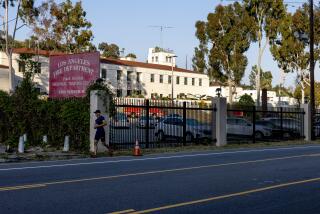Cities Make Their Own Weather
- Share via
ATLANTA — Forecasters have known for decades that big cities trap the sun’s rays, holding the heat in asphalt and concrete and staying consistently warmer than their suburbs.
But new research suggests that metropolises’ “urban heat islands” can actually create weather, churning out thunderstorms that dump rain hundreds of miles away.
National Aeronautics and Space Administration scientists discovered the pattern in Atlanta, a sprawling metro area increasingly choked by traffic and smog. They were interested in Atlanta in part because it has few natural boundaries to contain the sprawl.
“The island is getting bigger, and it’s causing changes in the climate all over the region,” said C.P. Lo, a University of Georgia geography professor who worked on the NASA project. “There are other cities developing similar trends, but Atlanta is the worst-case scenario.”
Major cities soak up heat all day in asphalt, concrete and buildings. In Atlanta, for example, the NASA team found that 95-degree days could cook rooftops to temperatures higher than 170 degrees.
When the sun sets, the cities release what they’ve stored in a sweltering sigh, giving off heat in a column of low pressure. The low pressure sucks in cooler air, and the collision creates clouds and thunderstorms.
Scientists are certain the storms are man-made because they occur at different times from naturally occurring summer storms, which can happen just about anywhere as the daytime air cools.
“The storms are occurring in Atlanta at very strange times, as opposed to your typical garden-variety storm,” said Dale Quattrochi of NASA’s Marshall Space Flight Center in Huntsville, Ala. “These are occurring at 2 o’clock in the morning.”
The man-made storms plod eastward, just as other storms do. Scientists said they watched storms created by the heat of downtown Atlanta soak towns on the Georgia-South Carolina line, nearly 150 miles away.
Such rain may seem like a blessing for states like Georgia, where farmers have been racked by drought for three years. But researchers say the man-made storms are a sign of a dangerous trend--an increasing number of cities with stifling, unhealthy air.
The scientists’ study of Atlanta was funded by a NASA grant. They also have studied Salt Lake City; Baton Rouge, La.; and Sacramento, using money from the federal Environmental Protection Agency.
Scientists have studied urban heat islands for decades. In New York, researchers noticed years ago that oncoming thunderstorms were splitting around the city, sheared off by the patch of hovering heat.
But in Atlanta, the new research showed storms popping up around the city on otherwise clear days.
A major contributing factor is that developers recklessly chop down trees to make room for suburbs, the scientists said. Trees provide shade and absorb many of the sun’s harmful rays. Without them, the effect is a sort of urban desert.
“There’s a slash-and-burn mentality of building suburbia,” Quattrochi said. “Just kind of knock them down because it’s cheaper.”
For the last 25 years, Lo said, Atlanta has lost about 55 acres of trees--the equivalent of 45 football fields--every day.
“You get a bigger piece of land, and you get a lawn, but there’s a downside of this,” he said. “The development is very fast, and that has brought along monumental changes in quality of air, in driving and congestion. Quite a few people are very concerned about this.”
Those people include Georgia Gov. Roy Barnes, who wrote a letter to NASA Administrator Dan Goldin praising the Atlanta study. Barnes said its lessons would be critical to a future of “sustainable development and environmental protection” in Georgia.
In addition to traditional smog-fighting schemes like mass transit and urban revitalization, Quattrochi urges “cool community” planning.
He says there’s no reason rooftops must be black, a color that traps heat. He urges cities to plant trees in strategic places. And he points out that concrete pavement, although more expensive, absorbs much less heat than asphalt.
The scientists hope to learn more this summer about how cities make weather--specifically, about how heat islands might affect regional weather and tornado activity. They plan to study Los Angeles--the nation’s famous smog capital--as well as Phoenix, Chicago and Houston.
And they want to look at cities that haven’t yet developed into large metropolises--like Nashville, Tenn., whose leaders want to make sure their city learns from others’ mistakes.
“They’re really scared,” Quattrochi said. “They don’t want to turn into another Atlanta.”
*
On the Net: wwwghcc.msfc.nasa.gov
More to Read
Sign up for Essential California
The most important California stories and recommendations in your inbox every morning.
You may occasionally receive promotional content from the Los Angeles Times.













